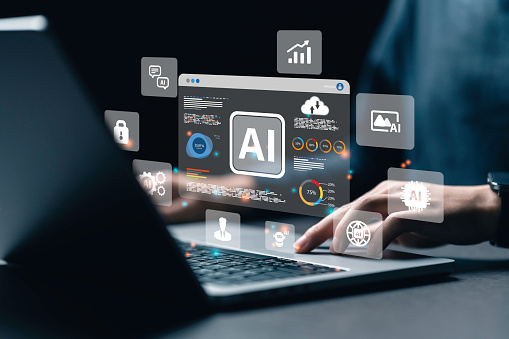Integrating AI and Machine Learning in Web Development
Introduction
Artificial Intelligence (AI) and Machine Learning (ML) are rapidly transforming various industries, and web development is no exception. These technologies are revolutionizing how websites are designed, developed, and maintained, offering new levels of personalization, automation, and efficiency. In this article, we explore how AI and ML can be integrated into web development to create smarter, more dynamic, and user-friendly websites.
1. Enhancing User Experience with AI-Powered Personalization
Overview: AI and ML enable websites to deliver highly personalized experiences by analyzing user behavior, preferences, and interactions. This level of personalization can significantly enhance user engagement, satisfaction, and conversion rates.
Key Integrations:
- Dynamic Content: AI algorithms can analyze user data to deliver personalized content, such as recommendations, tailored promotions, and targeted ads, based on individual preferences and past behavior.
- Personalized User Interfaces: Machine learning can help create adaptive user interfaces that change in real-time based on user behavior, offering a more intuitive and customized experience.
- Predictive Search: Implementing AI-powered predictive search can make it easier for users to find what they’re looking for by suggesting relevant search terms and results as they type.
Impact:
- Increased Engagement: Personalized experiences keep users more engaged, encouraging them to spend more time on the site and return more often.
- Higher Conversion Rates: Tailoring content and offers to individual users increases the likelihood of conversions, whether it’s making a purchase, signing up for a newsletter, or completing a form.
2. Automating Development Tasks with AI
Overview: AI can automate various aspects of the web development process, reducing the time and effort required to build and maintain websites. From code generation to testing and debugging, AI tools can streamline development workflows and improve efficiency.
Key Integrations:
- AI-Powered Code Generation: Tools like GitHub Copilot use AI to assist developers by suggesting code snippets, completing functions, and even generating entire sections of code based on natural language input.
- Automated Testing: Machine learning algorithms can be used to automate testing processes, identifying bugs and performance issues faster and more accurately than manual testing.
- Debugging and Code Review: AI tools can help identify and fix coding errors, optimize code for performance, and ensure best practices are followed during development.
Impact:
- Faster Development: Automating repetitive tasks allows developers to focus on more complex and creative aspects of the project, speeding up the development process.
- Improved Code Quality: AI-assisted debugging and code review lead to higher-quality code, reducing the likelihood of errors and improving overall site performance.
3. Optimizing Website Performance with AI
Overview: AI and ML can play a crucial role in optimizing website performance, ensuring that sites load quickly, function smoothly, and provide a seamless user experience. Performance optimization is essential for user satisfaction and search engine rankings.
Key Integrations:
- Load Time Prediction: AI can predict and analyze load times based on various factors such as user location, device type, and network conditions, allowing developers to optimize resources accordingly.
- Resource Management: Machine learning algorithms can dynamically allocate server resources, caching content, and managing bandwidth to ensure optimal performance under varying loads.
- Image and Video Optimization: AI tools can automatically compress images and videos without compromising quality, reducing file sizes and improving load times.
Impact:
- Better User Experience: Faster load times and smoother performance lead to a better user experience, reducing bounce rates and increasing user retention.
- SEO Benefits: Improved performance directly impacts search engine rankings, as search engines like Google prioritize fast-loading sites in their search results.
4. Enhancing Security with AI and ML
Overview: Security is a critical aspect of web development, and AI and ML can significantly enhance the security of websites by detecting and mitigating threats in real-time. These technologies can help protect against cyberattacks, data breaches, and other security vulnerabilities.
Key Integrations:
- Threat Detection: AI-driven security systems can analyze vast amounts of data to identify patterns indicative of cyber threats, such as DDoS attacks, SQL injections, and malware.
- Real-Time Monitoring: Machine learning models can continuously monitor website traffic and user behavior, flagging suspicious activities and potential vulnerabilities for immediate action.
- Automated Security Patches: AI can automatically apply security patches and updates as soon as they become available, reducing the risk of exploitation.
Impact:
- Proactive Defense: AI’s ability to detect and respond to threats in real-time allows for proactive defense measures, reducing the likelihood of successful attacks.
- Peace of Mind: Enhanced security measures provide peace of mind for both developers and users, knowing that their data is protected by advanced AI-driven systems.
5. Improving SEO with AI and ML
Overview: Search Engine Optimization (SEO) is essential for driving traffic to websites, and AI can significantly enhance SEO strategies by analyzing data, predicting trends, and automating optimization tasks.
Key Integrations:
- Content Optimization: AI tools can analyze existing content and suggest improvements to keywords, meta tags, and other SEO elements to increase visibility in search engine results.
- Voice Search Optimization: With the rise of voice search, AI can help optimize content for voice queries by understanding natural language and predicting the types of questions users might ask.
- Competitor Analysis: Machine learning algorithms can analyze competitors’ websites to identify strengths and weaknesses, helping businesses fine-tune their SEO strategies.
Impact:
- Higher Search Rankings: AI-driven SEO optimization leads to higher search engine rankings, increasing organic traffic to the website.
- Data-Driven Decisions: AI’s ability to analyze large datasets enables more informed, data-driven decisions in SEO strategy.
6. Enhancing Accessibility with AI
Overview: AI and ML can make websites more accessible to users with disabilities, ensuring that everyone can interact with digital content regardless of their abilities. Enhancing accessibility is not only a legal requirement in many jurisdictions but also a moral imperative for inclusive design.
Key Integrations:
- Automated Alt Text Generation: AI can automatically generate descriptive alt text for images, making them accessible to visually impaired users who rely on screen readers.
- Voice Assistants: Integrating AI-powered voice assistants into websites can help users navigate and interact with content through voice commands, improving accessibility for those with mobility impairments.
- Real-Time Captioning: AI can provide real-time captioning for video and audio content, making it accessible to users with hearing impairments.
Impact:
- Inclusive Design: AI-driven accessibility enhancements ensure that websites are inclusive and accessible to all users, regardless of their abilities.
- Compliance with Regulations: Implementing AI-driven accessibility features helps businesses comply with legal requirements related to web accessibility.
7. Creating Intelligent Chatbots and Virtual Assistants
Overview: AI-powered chatbots and virtual assistants are becoming increasingly common on websites, offering real-time customer support, answering queries, and guiding users through their online experience. These tools improve user engagement and reduce the workload on human support teams.
Key Integrations:
- Natural Language Processing (NLP): AI chatbots use NLP to understand and respond to user queries in a conversational manner, providing relevant information and assistance.
- Personalized Assistance: Machine learning allows chatbots to learn from user interactions and provide personalized recommendations, support, and guidance.
- 24/7 Availability: AI-driven chatbots can operate around the clock, providing users with immediate assistance regardless of time zones or business hours.
Impact:
- Enhanced Customer Support: AI chatbots improve customer support by providing instant, accurate responses to user inquiries, reducing wait times and improving satisfaction.
- Cost Efficiency: By automating customer support, businesses can reduce the need for large support teams, leading to cost savings.
Conclusion
Integrating AI and machine learning into web development offers a myriad of benefits, from enhancing user experiences and automating development tasks to improving performance, security, and accessibility. As these technologies continue to evolve, their role in web development will only become more significant, enabling the creation of smarter, more dynamic, and user-friendly websites. For businesses and developers, embracing AI and ML is not just an option but a necessity to stay competitive in the digital age.






